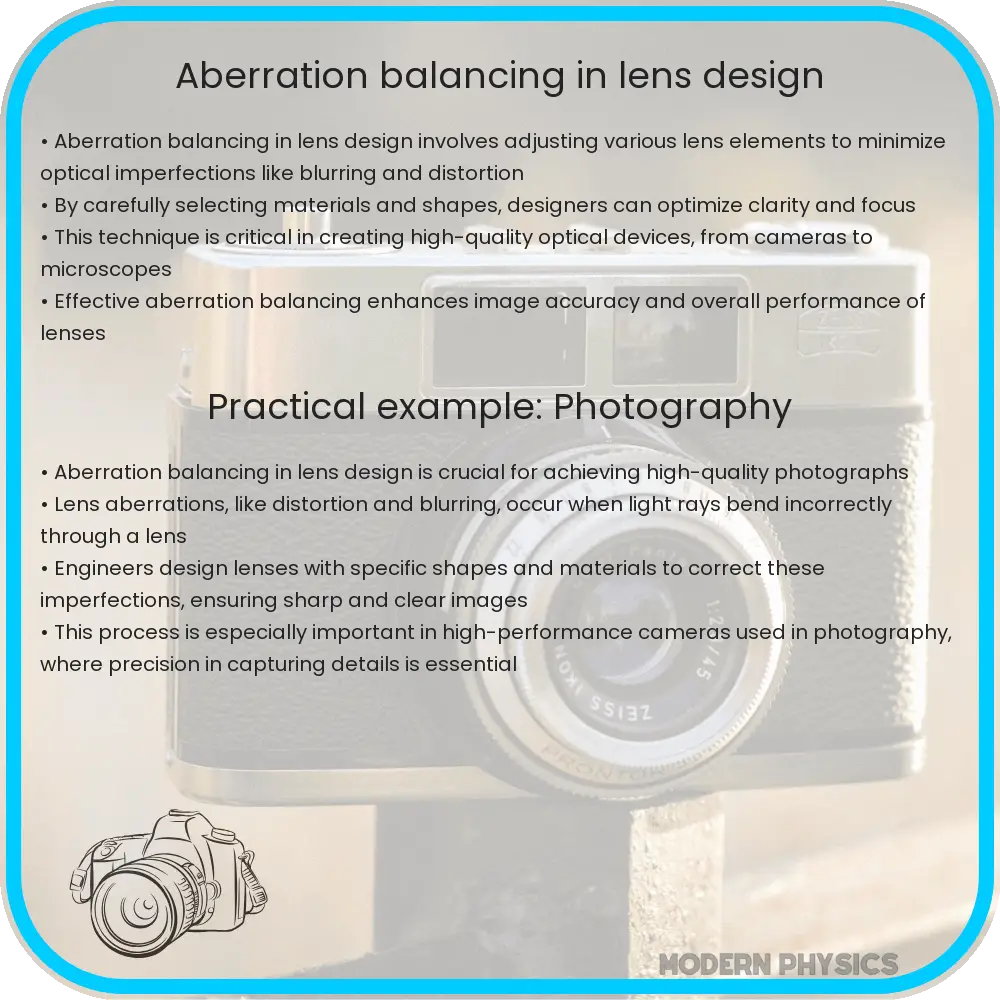Aberration balancing in lens design involves reducing optical distortions like spherical, chromatic aberrations to achieve high precision and clarity in image quality.

Aberration Balancing in Lens Design: Precision, Clarity & Efficiency
In optics, the goal of lens design is to produce clear and precise images. However, lenses are not perfect and can introduce various types of distortions or ‘aberrations’ that can affect image quality. Aberration balancing is a crucial aspect of lens design aimed at minimizing these distortions to achieve the best possible clarity and efficiency.
Understanding Optical Aberrations
Aberrations occur when light rays passing through a lens do not converge at a single focal point, resulting in a blurred or distorted image. There are several types of optical aberrations, including spherical aberration, chromatic aberration, coma, astigmatism, field curvature, and distortion.
Balancing Aberrations
To balance aberrations, lens designers often use a combination of techniques and corrective elements. Here’s an overview of some common strategies:
One famous lens design that uses these principles is the achromatic doublet, which consists of two elements made of different types of glass. The different dispersions of the glasses help to minimize chromatic aberration. Mathematically, if we denote the focal lengths of the two lenses as f1 and f2, the combined focal length f is given by:
\(\frac{1}{f} = \frac{1}{f_1} + \frac{1}{f_2}\)
Advanced Corrective Techniques
Apart from purely geometrical designs, modern lens systems often incorporate advanced technologies for aberration correction:
The Role of Materials
The choice of materials is also critical in balancing aberrations. Different types of glass or other transparent materials have unique refractive indices and dispersion properties. Materials such as fused silica, BK7, and fluorite are commonly used in high-precision lenses because of their favorable optical properties.
Moreover, coatings are applied to lens surfaces to reduce reflections and improve light transmission, further enhancing image quality. Anti-reflective coatings can help to minimize chromatic aberration and improve contrast.
Mathematical Modeling and Simulation
Modern lens design heavily relies on computer modeling and simulation. Optical designers use complex software tools that apply principles of geometrical and wave optics to simulate how lenses will perform under various conditions. Ray tracing algorithms allow designers to predict how light will behave as it passes through a lens system, identifying potential aberrations and helping to optimize the design.
One of the key mathematical tools is the Seidel Aberrations theory, which provides a way to quantify and correct primary optical aberrations. For instance, the wavefront aberration has a polynomial expansion:
\(W(\rho, \theta) = W_{040} \rho^4 + W_{131} \rho \cos \theta + W_{222} \rho^2 \cos 2\theta + …\)
where \(W_{ijk}\) are the aberration coefficients.
Aberration Balancing in Lens Design: Precision, Clarity & Efficiency
In optics, the goal of lens design is to produce clear and precise images. However, lenses are not perfect and can introduce various types of distortions or ‘aberrations’ that can affect image quality. Aberration balancing is a crucial aspect of lens design aimed at minimizing these distortions to achieve the best possible clarity and efficiency.
Understanding Optical Aberrations
Aberrations occur when light rays passing through a lens do not converge at a single focal point, resulting in a blurred or distorted image. There are several types of optical aberrations, including spherical aberration, chromatic aberration, coma, astigmatism, field curvature, and distortion.
Balancing Aberrations
To balance aberrations, lens designers often use a combination of techniques and corrective elements. Here’s an overview of some common strategies:
One famous lens design that uses these principles is the achromatic doublet, which consists of two elements made of different types of glass. The different dispersions of the glasses help to minimize chromatic aberration. Mathematically, if we denote the focal lengths of the two lenses as f1 and f2, the combined focal length f is given by:
\(\frac{1}{f} = \frac{1}{f_1} + \frac{1}{f_2}\)
Advanced Corrective Techniques
Apart from purely geometrical designs, modern lens systems often incorporate advanced technologies for aberration correction:
The Role of Materials
The choice of materials is also critical in balancing aberrations. Different types of glass or other transparent materials have unique refractive indices and dispersion properties. Materials such as fused silica, BK7, and fluorite are commonly used in high-precision lenses because of their favorable optical properties.
Moreover, coatings are applied to lens surfaces to reduce reflections and improve light transmission, further enhancing image quality. Anti-reflective coatings can help to minimize chromatic aberration and improve contrast.
Mathematical Modeling and Simulation
Modern lens design heavily relies on computer modeling and simulation. Optical designers use complex software tools that apply principles of geometrical and wave optics to simulate how lenses will perform under various conditions. Ray tracing algorithms allow designers to predict how light will behave as it passes through a lens system, identifying potential aberrations and helping to optimize the design.
One of the key mathematical tools is the Seidel Aberrations theory, which provides a way to quantify and correct primary optical aberrations. For instance, the wavefront aberration has a polynomial expansion:
\(W(\rho, \theta) = W_{040} \rho^4 + W_{131} \rho \cos \theta + W_{222} \rho^2 \cos 2\theta + …\)
where \(W_{ijk}\) are the aberration coefficients.
Conclusion
Aberration balancing is an integral part of lens design that directly impacts the performance and quality of optical systems. By understanding the different types of aberrations and employing a range of corrective techniques, from advanced lens shapes to cutting-edge materials and adaptive optics, designers can create lenses that produce exceptionally clear and precise images. Continuous advancements in computational tools and materials science promise even more refined solutions to the age-old challenge of optical aberration, ensuring that we achieve ever greater clarity and efficiency in our visual technologies.
